Detroit Tigers: Is James McCann still the long-term solution behind the plate?
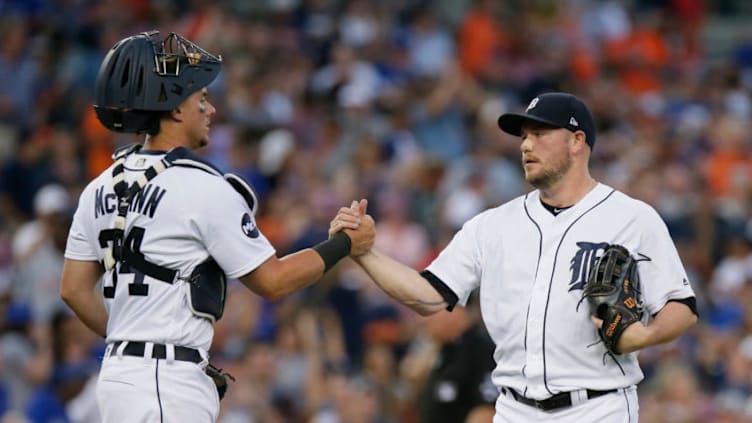
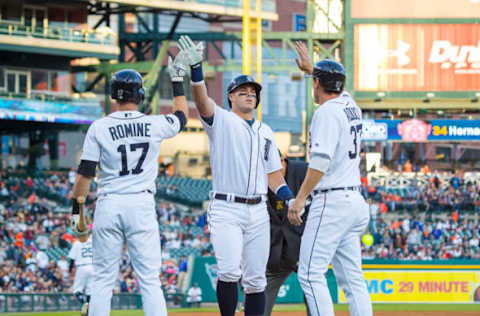
Detroit Tigers catcher James McCann has been on a tear at the plate as of late. This hot streak, coupled with Alex Avila being dealt begs the question, is McCann still the team’s catcher of the future?
Detroit Tigers fans have seen some much-improved play out of James McCann in recent weeks.
Since the calendar turned to June 20, McCann is batting .385 with a .452 on-base percentage, a .615 slugging percentage and a 1.067 OPS.
The same span has also seen the 27-year-old notch a 188 wRC+, a .231 ISO, a .452 wOBA, 13 RBI, nine runs scored, six doubles and three home runs in 73 plate appearances.
Fellow backstop Alex Avila’ presence on the roster limited McCann’s plate appearances due to his own strong play.
However, with Avila now playing for the Cubs, it opens up a steady stream of playing time for McCann.
John Hicks will chip in behind the plate as well, but with the path cleared for McCann to catch full time, it raises the question, is James McCann still the Detroit Tigers’ long-term solution behind the dish?
The third-year veteran isn’t exactly a rookie any more at 27. While he’s still young, McCann hasn’t been able to put it all together on a consistent basis.
We’ve seen his offense take off in recent weeks, while his defensive abilities were on fine display last season.
Is he still the catcher of the future in the Motor City? Let’s take a deep dive to find out.
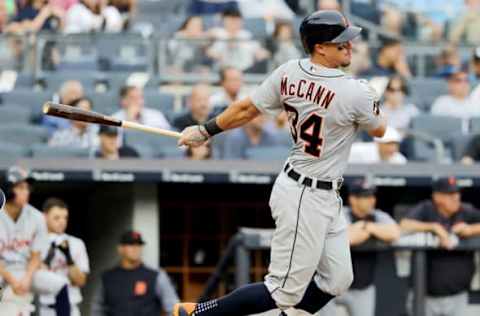
2017 offense
James McCann has clearly figured something out in the batter’s box, as he’s been scathing hot at the plate lately.
McCann’s recent run of form helped him offset a dreadful statistical start to the 2017 campaign.
In 144 plate appearances prior to going on a tear, the catcher was hitting .183 with a .259 on-base percentage, .381 slugging percentage, a .640 OPS, a .273 wOBA, a .198 ISO and a 65 wRC+.
Overall, McCann is how hitting .251 with a .324 on-base percentage, a .461 slugging percentage, a .785 OPS, a .333 wOBA, a .209 ISO and a 107 wRC+.
McCann’s improved offensive play has helped bumped his WAR up to 1.3 overall.
In terms of players still on Detroit’s roster, only Justin Upton, Ian Kinsler and Jose Iglesias rank higher.
Additionally, his walk percentage is up (6.2% in 2016 to 7.8% in 2017) and his strikeout percentage is down (29.2% in 2016 to 24.4% in 2017).
Those are perfectly acceptable, even strong offensive numbers for a defensive-oriented catcher.
For most glove-first backstops, they need to hit just enough to contribute offensively to provide value, and McCann is doing more than his fair share as a strong defensive catcher.
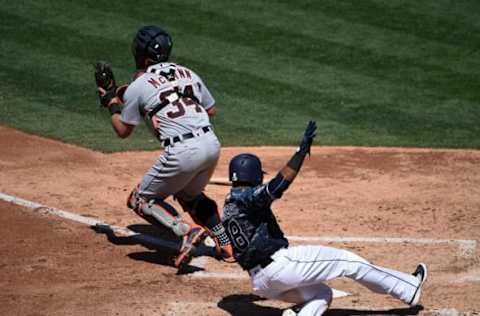
2017 defense
Expect McCann hasn’t posted the same defensive metrics this year that helped him finish as a 2016 finalist for the Gold Glove at his position in the American League.
He showed defensive promise last year, and has flashed that same promise this season. However, the flashes have promise have come with less and less frequency.
Sure, he’s made some standout throws this season that have prompted the usage of the “McCannon” moniker, but his overall defensive metrics aren’t what they used to be.
McCann logged 7 rSB of seven and a 9 DRS en route to making it as a finalist for the Gold Glove in 2016.
The Detroit Tigers catcher led all Major League catchers with at least 800 innings that season with his 7 rSB, and finished only behind Buster Posey and Salvador Perez in terms of DRS (McCann had a +9 DRS).
This year, however, things are a bit different—and not in a good way.
Of catchers with at least 450 innings caught in 2017, only four players have a lower rSB number than McCann’s -1.
In terms of the same qualified catchers, only Jonathan Lucroy, Wellington Castillo, Tony Wolters, Brian McCann and Tyler Flowers have posted a lower DRS than McCann’s -3 stat this season.
Additionally, McCann’s caught stealing percentage is down significantly from 45% last year to only 30% this season.
The 2016 campaign saw opposing teams steal just 33 bases off Detroit’s starting backstop. This season, opposing teams have already racked up 30.
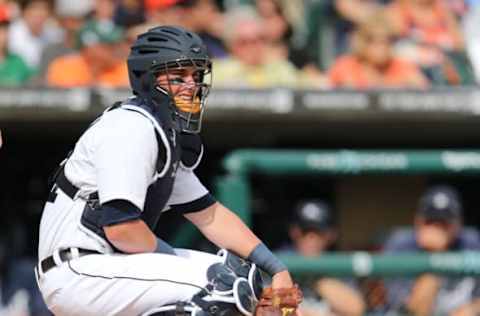
Pitch framing
If McCann was providing the same defensive value that he did in 2016, pitch framing wouldn’t be as much of an issue.
Perez, one of the better defensive backstops in baseball and the American League Gold Glove winner at catcher in 2016, routinely grades out poorly in pitch framing.
In other words, below-average pitch framing is a little easier to live with when your team’s catcher is throwing out 45% of would-be base stealers.
However, with McCann’s other defensive metrics trending down, his pitch framing is thrust into the spotlight even more so.
James McCann and pitch framing
According to Statcorner’s pitch framing leaderboard for 2017, only four catchers have a lower RAA (or runs above average) number—Avila, Willson Contreras, Perez and Lucroy—than McCann’s -15.9.
What’s more, Detroit’s backstop is seeing 2.13 calls per game go against him. Only 13 catchers in the league have a lower number than McCann’s -2.13 per game.
While that may not seem like a lot, every pitch counts. Add those up over the course of a season and it’s a significant amount of potential strikes taken away.
By comparison, Atlanta’s Tyler Flowers may be the best pitch framer in the league. The backstop is worth 20.2 runs above average, and is getting 2.46 calls per game.
Below-average pitch-framing numbers aren’t anything new for McCann.
He finished tied for last in the league in RAA with a -15.6 number and had 1.16 calls go against him per game as a rookie (both per Statcorner) in 2015.
However, he showed improvement in 2016, suggesting he could once again rebound.
Last season, according to Statcorner, McCann checked in with a -2.6 RAA, while only having 0.22 calls go against him.
Neither of those numbers were within striking distance of the league lead, but they represented significant improvements over his rookie campaign.
If he can turn things around once again from a pitch-framing standpoint it can go a long ways towards boosting his defensive value.
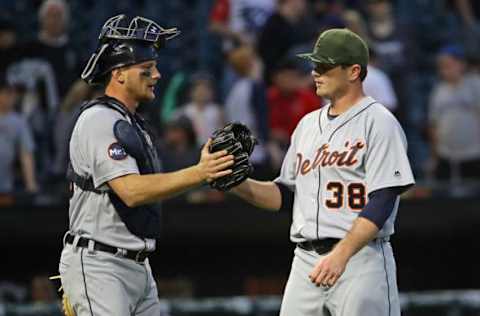
If not James McCann, than who?
In the event that James McCann isn’t the long-term solution behind the plate for the Detroit Tigers, than who would take over?
The most ready-made option is John Hicks, who like McCann is 27.
Hicks took CC Sabathia deep for a three-run shot in Tuesday’s win, and has generally provided solid offensive production in limited playing time for Detroit this season.
In 73 plate appearances, Hicks has accumulated 15 RBI, 12 runs scored, four home runs and a stolen base.
He’s also notched a 132 wRC+, a .370 wOBA and a .257 ISO to go along with a .300 batting average, a .329 on-base percentage, a .557 slugging percentage and a .876 OPS.
It obviously remains to be seen whether Hicks can maintain some of those numbers given more plate appearances, but he clearly has the ability to do some damage at the plate.
Hicks is actually a better pitch framer (-0.4 RAA, 0.67 calls against him per game) than McCann in a much smaller sample size.
Similar to his offense, it remains to be seen if those stats are sustainable, but Hicks shows promise nonetheless.
Further down the road
Recent draft pick Sam McMillan looks like a solid bet to eventually succeed McCann. However, he’s just 18 and is only beginning his minor league career in the Gulf Coast League.
Detroit went way over slot value to sign the fifth-round pick out of high school, so they’re clearly invested in and believe in him.
The Tigers have other backstops further up the organizational ladder, but many of them appear to be defensive-first types who don’t make a massive impact (relatively speaking) on offense. These catchers include Joey Morgan, Arvicent Perez and Grayson Greiner.
Greiner is the closets of the group to the Majors. He’s hitting .245 with a .779 OPS at Double-A Erie, but isn’t tested at Triple-A and is already 24.
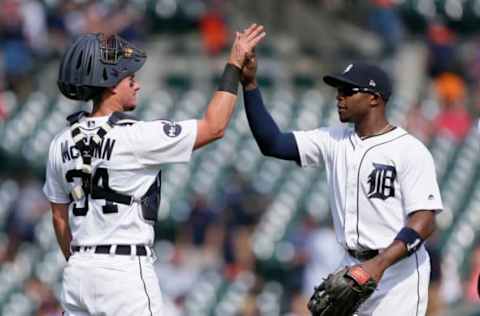
Is James McCann the long-term answer behind the plate for the Detroit Tigers?
The defensive numbers may a blip on the radar and not a long-term trend in the grand scheme of things for James McCann. If that’s the case and McCann continues to improve at the plate, he’ll be the catcher in the Motor City until McMillan or one of the other prospects is ready to take over.
If his defensive numbers continue to struggle and his offense comes back to earth? That’s another story, especially if the 27-year-old can’t figure out right-handed pitching.
In 141 plate appearances versus righties this year, McCann is batting .205 with a .286 on-base percentage, a .336 slugging percentage and a .622 OPS.
His career OPS against right-handers is just .580, compared to a .914 numbers versus southpaws.
If this trend continues in McCann’s career, the Tigers will consistently be on the look-out for backstops who can hit right-handers to pair with the former second-round pick.
This worked out brilliantly in the early stages of 2017 with Alex Avila getting off to a torrid start against right-handers. However, finding someone with Avila’s ability to hit on a yearly basis is easier said than done.
Next: Breaking down all angles of the Justin Wilson/Alex Avila deal
All told, if James McCann puts it all together, he’ll be a Detroit Tigers fixture for the foreseeable future.